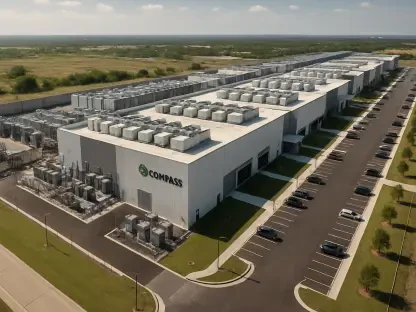I’m thrilled to sit down with Matilda Bailey, a renowned networking specialist with a deep focus on cutting-edge technologies and trends in cellular, wireless, and next-gen solutions. With her extensive expertise in the digital infrastructure space, Matilda offers unique insights into the explosive growth of data centers and the broader implications of the AI boom. Today, we’ll explore the driving forces behind AI infrastructure investments, the risks and strategies surrounding data center development, and how firms are positioning themselves in this rapidly evolving landscape.
Can you start by shedding light on what’s fueling the massive surge in AI infrastructure and data center investments right now?
Absolutely, Kendra. The primary driver is the unprecedented demand for computing power brought on by artificial intelligence. AI applications, especially machine learning and large language models, require enormous amounts of data processing and storage, which data centers are uniquely equipped to handle. Beyond that, the shift to cloud computing and the Internet of Things has compounded the need for robust, scalable infrastructure. Investors see data centers as a backbone for these technologies, making them a hot spot for capital inflow compared to more volatile options like AI stocks, where picking winners is much harder.
How do you see the risk of overcapacity playing out in the data center space, and why is it a concern?
Overcapacity is a real worry when you have this much money flooding into a sector so quickly. Historically, we’ve seen similar patterns in industries like telecommunications during the dot-com bubble, where infrastructure was built far beyond demand, leading to bankruptcies and stranded assets. In the data center space, if too many facilities come online without secured tenants, operators could struggle with low utilization rates, squeezing returns for investors. It’s a classic boom-bust risk, and being selective about where and how much to build is critical to avoiding those pitfalls.
What strategies can firms use to mitigate the dangers of overbuilding in this market?
One effective approach is focusing on pre-leased developments, where you have long-term commitments from tenants before breaking ground. This ensures there’s demand for the space from day one. Another tactic is targeting markets with high barriers to entry—like areas where land is scarce or zoning is tough—which naturally limits oversupply. Additionally, incorporating flexible design elements in data centers can allow for scalability, so you’re not locked into excess capacity if demand shifts. It’s all about balancing ambition with caution.
Speaking of ambitious plans, how are major players setting their fundraising and expansion goals for data centers, and what’s the thinking behind these targets?
Many firms are setting aggressive targets because they see data centers as a cornerstone of future growth. For instance, aiming for billions in equity fundraising reflects a belief that the demand for digital infrastructure will only grow with AI and cloud adoption. The strategy often involves diversifying geographically—targeting regions like Europe, Asia, and Latin America where digital transformation is accelerating. These goals align with a broader vision of building resilient, long-term revenue streams that can weather tech sector volatility while capitalizing on global trends.
How important is the focus on high-quality facilities and long-term contracts in ensuring the success of data center projects?
It’s absolutely crucial. High-quality facilities—think state-of-the-art cooling, energy efficiency, and security— attract top-tier tenants like hyperscale cloud providers who need reliability for their operations. Long-term contracts, often spanning 15 years or more, lock in revenue and reduce the risk of vacancies. They often include rent escalators, which are built-in increases in lease payments over time, helping to offset inflation and operational costs. This combination creates a stable investment profile, which is especially appealing to institutional investors like insurance funds.
I’ve heard about firms targeting challenging markets with limited access to entitled land. Can you explain why that’s seen as a strategic advantage?
Certainly. Tricky markets—those with scarce land or complex regulatory hurdles—tend to have less competition because the barriers to entry are so high. If you can navigate those challenges, you often end up with a prime location that’s in high demand, especially for data centers that need to be close to urban centers or key internet hubs for low latency. This strategy not only reduces the risk of oversupply in that area but also positions you as a go-to provider for tenants who have few other options. It’s a way to carve out a defensible niche.
How has past experience in financing infrastructure projects shaped current approaches to direct data center development?
Experience in financing gives firms a deep understanding of the risk profiles and cash flow dynamics of these projects. For instance, if you’ve funded data centers through credit vehicles, you know what makes a facility bankable—things like tenant creditworthiness and contract length. That insight translates directly into smarter development decisions, from site selection to design specs. It also helps in structuring deals that appeal to a wide range of capital sources, whether that’s private equity or insurance money, ensuring projects are well-funded and sustainable.
Looking ahead, what’s your forecast for the data center industry over the next decade, considering both opportunities and challenges?
I’m optimistic about the data center industry over the next decade, but it won’t be without bumps. The opportunity lies in the relentless growth of data consumption—AI, 5G, and edge computing will keep demand high. We could see data centers evolving into more specialized facilities tailored for specific workloads. However, challenges like overbuilding, energy constraints, and regulatory scrutiny on environmental impacts will test the industry. Firms that prioritize sustainability, strategic location, and tenant partnerships will likely come out ahead. It’s going to be a dynamic space, and adaptability will be key.









